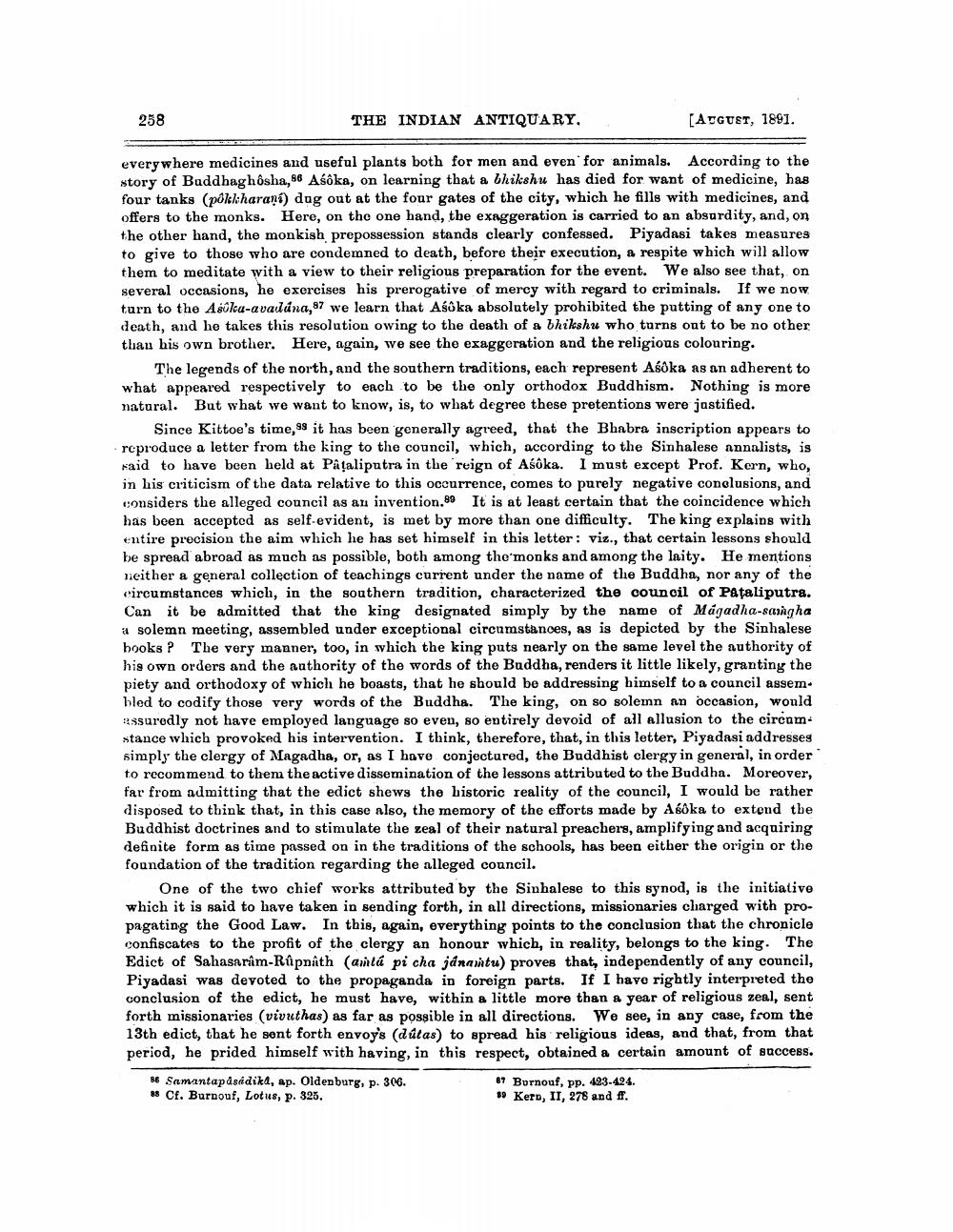________________
258
THE INDIAN ANTIQUARY,
[AUGUET, 1891.
everywhere medicines and useful plants both for men and even for animals. According to the story of Buddhaghosha,86 Asoka, on learning that a bhikshu has died for want of medicine, has four tanks (poll: harani) dug out at the four gates of the city, which he fills with medicines, and offers to the monks. Here, on the one hand, the exaggeration is carried to an absurdity, and, on the other hand, the monkish prepossession stands clearly confessed. Piyadasi takes measures to give to those who are condemned to death, before their execution, a respite which will allow them to meditate with a view to their religious preparation for the event. We also see that, on several occasions, he exercises his prerogative of mercy with regard to criminals. If we now turn to the Asúla-avaulúna, 97 we learn that Asoka absolutely prohibited the putting of any one to death, and he takes this resolution owing to the death of a bhikshu who turns out to be no other than his own brother. Here, again, we see the exaggeration and the religious colouring.
The legends of the north, and the southern traditions, each represent Asoka as an adherent to what appeared respectively to each to be the only orthodox Buddhism. Nothing is more natural. But what we want to know, is, to what degree these pretentions were justified.
Since Kittoe's time, 99 it has been generally agreed, that the Bhabra inscription appears to reproduce a letter from the king to the council, which, according to the Sinhalese annalists, is said to have been held at Pâļalipatra in the reign of Asoka. I must except Prof. Kern, who, in his criticism of the data relative to this occurrence, comes to purely negative conclusions, and considers the alleged council as an invention.89 It is at least certain that the coincidence which has been accepted as self-evident, is met by more than one difficulty. The king explains with entire precision the aim which he has set himself in this letter: viz., that certain lessons should be spread abroad as much as possible, both among the monks and among the laity. He mentions neither a general collection of teachings current under the name of the Buddha, nor any of the circumstances which, in the southern tradition, characterized the council of Pataliputra. Can it be admitted that the king designated simply by the name of Mágadha-saingha a solemn meeting, assembled under exceptional circumstances, as is depicted by the Sinhalese books? The very manner, too, in which the king puts nearly on the same level the authority of his own orders and the authority of the words of the Buddha, renders it little likely, granting the piety and orthodoxy of which he boasts, that he should be addressing himself to a council assem. bled to codify those very words of the Buddha. The king, on so solemn an occasion, would assuredly not have employed language so even, so entirely devoid of all allusion to the circamstance which provoked his intervention. I think, therefore, that, in this letter, Piyadasi addresses simply the clergy of Magadha, or, as I have conjectured, the Buddhist clergy in general, in order to recommend to them the active dissemination of the lessons attributed to the Buddha. Moreover, far from admitting that the edict shews the historic reality of the council, I would be rather disposed to think that, in this case also, the memory of the efforts made by Aśôka to extend the Buddhist doctrines and to stimulate the zeal of their natural preachers, amplifying and acquiring definite form as time passed on in the traditions of the schools, has been either the origin or the foundation of the tradition regarding the alleged council.
One of the two chief works attributed by the Sinhalese to this synod, is the initiative which it is said to have taken in sending forth, in all directions, missionaries charged with propagating the Good Law. In this, again, everything points to the conclusion that the chronicle confiscates to the profit of the clergy an honour which, in reality, belongs to the king. The Edict of Sahasa riim-Rûpnath (antá pi cha janaitu) proves that, independently of any council, Piyadasi was devoted to the propaganda in foreign parts. If I have rightly interpreted the conclusion of the edict, he must have, within a little more than a year of religious zeal, sent forth missionaries (vivuthas) as far as possible in all directions. We see, in any case, from the 13th edict, that he sent forth envoy's (dútas) to spread his religious ideas, and that, from that period, he prided himself with having, in this respect, obtained a certain amount of success.
86 Samantapåsadika, ap. Oldenburg, p. 306. 88 Cf. Burnouf, Lotus, p. 325.
87 Burnouf, pp. 423-424. 89 Kern, II, 278 and ff.




